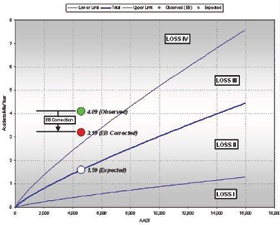U.S. Department of Transportation
Federal Highway Administration
1200 New Jersey Avenue, SE
Washington, DC 20590
202-366-4000
| << HSIP Project Evaluation | Table of Contents | Crash Reduction Analysis System Hub - Florida >> |
Best for printing: [PDF] (2.3 MB)
To view PDF files, you can use the Acrobat® Reader®.
Incorporating the Empirical Bayes (EB) method into project evaluations reduces the potential overestimation of safety benefits due to regression-to-the-mean. While the EB method is not difficult in itself, it requires safety performance functions (SPF) for the type of facilities on which projects are being evaluated.
SPFs were originally developed by Colorado Department of Transportation (CDOT) for use in the network screening process. While crash rates are commonly used to measure safety, the crash rate implies a linear relationship between safety and exposure, which can often be misleading since rates change with Annual Average Daily Traffic (AADT). To capture how this rate change takes place, design engineers at the CDOT started to calibrate SPFs in the late 1990s, as part of the development of the Level of Service of Safety (LOSS) concept. LOSS is used to identify locations with potential for safety improvement and reflects how a roadway segment is performing in regard to its expected crash frequency and severity at a specific level of AADT, based on the SPF. By 2001, CDOT had calibrated SPFs for all public roadways (state and local) in Colorado, stratified by the number of lanes, terrain, environment, and functional classification. In 2009, CDOT in collaboration with consultants developed SPFs for all intersection types.
The development of SPFs has not only advanced CDOT’s network screening process, it also has enabled CDOT to institutionalize the use of the EB method as a standard procedure for safety evaluation analysis. Colorado has traditionally used a simple spreadsheet with three to five years of before and after data to conduct project evaluations. CDOT is currently working on applying an EB correction to evaluate sites on an SPF graph as shown. The use of the EB method is particularly effective when it takes a long time for a few crashes to occur, as is often the case on Colorado rural roads.

CDOT developed SPFs for all state and local roadway facilities and intersection types. The development of the SPFs has enabled CDOT to fully institutionalize the EB method for all safety analysis at CDOT and reduce the effects of regression-to-the-mean.
Bryan Allery
Colorado Department of Transportation
303-757-9967
bryan.allery@dot.state.co.us
Jake Kononov
Colorado Department of Transportation
303-757-9973
jake.kononov@dot.state.co.us
| << HSIP Project Evaluation | Table of Contents | Crash Reduction Analysis System Hub - Florida >> |
